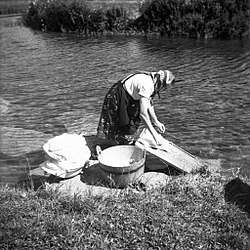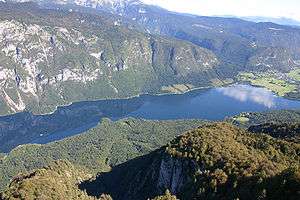Obrh
Obrh Creek (pronounced [ˈoːbəɾx]) is a losing stream that originates and terminates in the Lož Karst Field in the Municipality of Loška Dolina. It is a watercourse in the Ljubljanica watershed. It is created by the confluence of Little Obrh Creek (Slovene: Mali Obrh) and Big Obrh Creek (Slovene: Veliki Obrh); the latter is fed by two tributaries: Brežiček Creek and Viševek Brežiček Creek (Slovene: Viševski Brežiček). The confluence, at which point it is simply named Obrh, lies west of the village of Pudob.[1] In the northwest, limestone part of the karst field, Obrh Creek starts to drain into many sinkholes, and higher water flows into 850-meter (2,790 ft) Golobina Cave. The stream re-emerges at the spring of the Stržen River 2 kilometers (1.2 mi) to the northwest on the southeast edge of the Cerknica Karst Field.[2][3]
| Obrh Creek | |
|---|---|
 Washing clothes in Obrh Creek in 1962 | |
| Location | |
| Country | Slovenia |
| Physical characteristics | |
| Source | |
| • location | Little Obrh Creek (Slovene: Mali Obrh) |
| • coordinates | 45°40′24.68″N 14°28′45.57″E |
| 2nd source | |
| • location | Big Obrh Creek (Slovene: Velki Obrh) |
| • coordinates | 45°41′59.63″N 14°30′40.93″E |
| Mouth | |
• location | Sinks into Golobina Cave in the Lož Karst Field |
| Basin features | |
| Progression | Stržen→ Rak→ Unica→ Ljubljanica→ Sava→ Danube→ Black Sea |
Name
The name Obrh comes from the Slovene common noun obrh, referring to a powerful karst spring that usually surfaces below a cliff, creating a small deep lake that flows into a valley. The noun is originally a fused prepositional phrase, *ob vьrxъ 'at the summit' (i.e., at the highest point of the watercourse).[4]
References
- Komac, Blaž, Karel Natek, & Matija Zorn. 2008. Geografski vidiki poplav v Sloveniji (= Geografija Slovenije 20). Ljubljana: ZRC, p. 85.
- Gunn, John (ed.). 2004. Encyclopedia of Caves and Karst Science. New York: Fitzroy Dearborn, p. 430.
- Shaw, Trevor R. 2008. Foreign Travellers in the Slovene Karst: 1486–1900. Ljubljana: ZRC, p. 32.
- Snoj, Marko (2009). Etimološki slovar slovenskih zemljepisnih imen. Ljubljana: Modrijan. p. 287.
External links

- Obrh Creek on Geopedija
